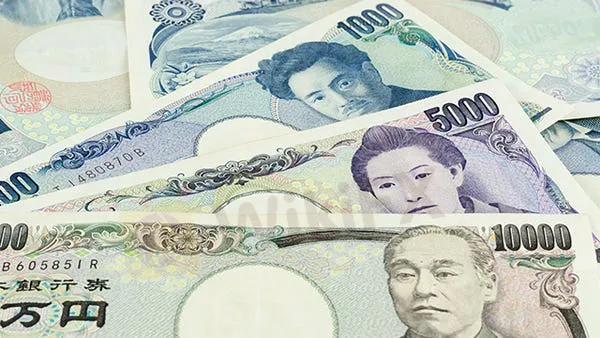简体中文
繁體中文
English
Pусский
日本語
ภาษาไทย
Tiếng Việt
Bahasa Indonesia
Español
हिन्दी
Filippiiniläinen
Français
Deutsch
Português
Türkçe
한국어
العربية
What Forex Traders Need to Know About the Yen
Abstract:The yen is one of the world's most-traded currencies on the foreign exchange market, commonly referred to as "forex".
Key Takeaways
The yen is one of the world's most-traded currencies on the foreign exchange market, commonly referred to as “forex”. Currency rates are notoriously difficult to predict, and most models seldom work for more than brief periods of time.
Although Japanese domestic debt can be high, the yen is often seen as a safe-haven investment. Trading the yen is notoriously difficult, and should only be attempted by seasoned traders.
Introduction to the Yen
Just seven currencies account for 83% of the forex market, and the Japanese yen is one of the largest currencies, in terms of international trade and forex trading. Japan is one of the largest economies in the world, being one of the nations with the highest GDP; it is also one of the largest exporters, in dollar terms.
All of the major currencies in the forex market have central banks behind them. In the case of the Japanese yen, it is the Bank of Japan (BoJ). Like most developed-country central banks, the BoJ has a mandate to act in a fashion that encourages growth and minimizes inflation.
In the case of Japan, however, deflation has been a persistent threat for many years, and the BOJ has pursued a policy of very low rates in the hope of stimulating demand and economic growth; at various points in the 2010s, real rates in Japan were actually slightly negative.

The Economy Behind the Yen
The Japanese economy has some particular and peculiar attributes that yen traders need to understand. Firstly, despite its size, Japan has been notably lacking in growth since the collapse of its equity and real estate bubbles in 1990. Writers often refer to the ensuing years as a “lost decade” in Japan because of this reason. Since then, growth rarely exceeded 2% in Japan between 2001 and 2011, and went down 29% from 2012 to 2015. Japan is also notable for inflation, or rather its almost near-absence of it; Japan has actually experienced deflation for much of the last 20 years.
Second, Japan is also among the oldest major economies in the world and has one of the lowest fertility rates. That suggests an increasingly aging workforce with fewer and fewer younger workers to support the economy through taxation and consumption. Because of this Japan, once quite closed to immigration, recently began opening its borders to foreign workers to address labor shortages.
Lastly, Japan is also an advanced economy with a well-educated workforce. Although industries like shipbuilding have somewhat migrated to countries like South Korea and China, Japan is still a leading manufacturer of consumer electronics, autos, and technological components. This has left Japan with significant exposure to the global economy.

Drivers of the Yen
There are several theories that attempt to explain foreign exchange rates. Purchasing power parity, interest rate parity, the Fisher effect and balance of payments models all offer explanations of the “right” exchange rate, based on factors like relative interest rates, price levels and so forth. In practice, these models do not work especially well in the real market—real market exchange rates are determined by supply and demand, which includes a variety of market psychology factors.
Major economic data includes the release of GDP, retail sales, industrial production, inflation, and trade balances. Investors should also take note of the information on employment, interest rates (including scheduled meetings of the central bank) and the daily news flow; natural disasters, elections, and new government policies can all have significant impacts on exchange rates.
In the case of Japan and yen traders, the Tankan survey is particularly noteworthy. Many countries report information on business confidence, and the Tankan is a quarterly report published by the Bank of Japan. The Tankan is seen as a very important report, and often moves trading in Japanese stock and currency.
In many respects, BoJ policy drives carry trades across the world. Carry trading refers to borrowing money in a low-interest-rate environment and then investing that money in higher-yielding assets from other countries. With a stated policy of near-zero interest rates, Japan has long been a major source of capital for that trade. That also means, though, that talk of higher rates in Japan can send ripples throughout the currency markets.
(Source: www.investopedia.com/articles/forex/japanese-yen-what-fx-traders-should-know.asp)
Disclaimer:
The views in this article only represent the author's personal views, and do not constitute investment advice on this platform. This platform does not guarantee the accuracy, completeness and timeliness of the information in the article, and will not be liable for any loss caused by the use of or reliance on the information in the article.
Read more

Weekly Fundamental Gold Price Forecast: Hawkish Central Banks a Hurdle
WEEKLY FUNDAMENTAL GOLD PRICE FORECAST: NEUTRAL

Gold Prices at Risk, Eyeing the Fed’s Key Inflation Gauge. Will XAU/USD Clear Support?
GOLD, XAU/USD, TREASURY YIELDS, CORE PCE, TECHNICAL ANALYSIS - TALKING POINTS:

British Pound (GBP) Price Outlook: EUR/GBP Downside Risk as ECB Meets
EUR/GBP PRICE, NEWS AND ANALYSIS:

Dollar Up, Yen Down as Investors Focus on Central Bank Policy Decisions
The dollar was up on Thursday morning in Asia, with the yen and euro on a downward trend ahead of central bank policy decisions in Japan and Europe.
WikiFX Broker
Latest News
Geopolitical Events: What They Are & Their Impact?
Top 10 Trading Indicators Every Forex Trader Should Know
ASIC Sues Binance Australia Derivatives for Misclassifying Retail Clients
WikiFX Review: Is FxPro Reliable?
Malaysian-Thai Fraud Syndicate Dismantled, Millions in Losses Reported
Trading frauds topped the list of scams in India- Report Reveals
Why Do You Feel Scared During Trade Execution?
WikiFX Review: Something You Need to Know About Markets4you
Revolut Leads UK Neobanks in the Digital Banking Revolution
Fusion Markets: Safe Choice or Scam to Avoid?
Currency Calculator


